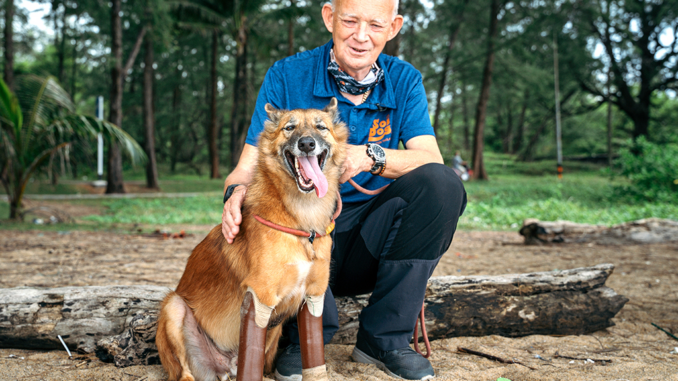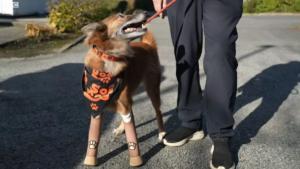
Introduction: A New Chapter for a Resilient Amputee Dog
Life can be tough for animals who experience life-changing injuries, but the story of one brave dog from Hornsea has given hope to pet owners everywhere. After losing its legs, this courageous dog received a pair of prosthetic limbs that have allowed it to live life as fully as ever. From struggling to walk to running around with newfound freedom, this amputee dog’s journey is one of resilience, love, and the power of modern technology.
Are prosthetic legs the key to an amputee dog’s happiness? Let’s explore how this dog overcame the odds and how prosthetics are helping disabled pets live normal, fulfilling lives.
How Prosthetic Legs Are Changing the Lives of Disabled Pets
Amputee dogs, like humans, can face significant challenges when it comes to getting around. However, prosthetic legs are becoming an increasingly popular solution, providing mobility and an enhanced quality of life. In fact, prosthetics for pets have evolved significantly in recent years, thanks to advancements in technology and veterinary care.
What Are Prosthetic Legs for Dogs?
Prosthetic legs are custom-designed devices that replace a lost limb, enabling pets to walk, run, and play like they did before their injury. They are typically made from lightweight yet durable materials, offering support and comfort to pets who have lost a leg or multiple limbs. These prosthetics are designed to fit a dog’s body perfectly, ensuring that it can regain mobility and enjoy life to the fullest.
The Amputee Dog’s Story: Overcoming Adversity
This heartwarming tale begins with a dog in Hornsea who, after facing a severe injury, had to have its legs amputated. For any animal, losing a limb can be a traumatic experience, both physically and emotionally. But this dog’s story doesn’t end there. With the help of a compassionate veterinary team, the owners decided to try something remarkable: fitting the dog with prosthetic legs.
How Did the Dog’s Injury Happen?
While the specifics of the injury are unclear, it’s clear that the dog had experienced a traumatic event that led to the amputation of its legs. Like many pets who suffer accidents or illnesses, the dog’s ability to move around was severely limited. This left its owners concerned, unsure of how they could improve their beloved pet’s quality of life.
The Breakthrough Moment: Getting Prosthetic Legs
When the dog’s owners first learned about prosthetics for dogs, they were hopeful but unsure. After all, it’s not every day that you hear about dogs walking around with artificial limbs! However, after consulting with a skilled veterinarian and prosthetic expert, the decision was made to go ahead with the procedure.
The prosthetics were custom-designed, tailored specifically to the dog’s size and shape. The process involved multiple fittings and adjustments, ensuring that the prosthetics would provide both support and comfort.
What Are the Benefits of Prosthetic Legs for Dogs?
Prosthetic legs help amputee dogs regain their mobility and sense of independence. For this dog, it meant being able to walk and run again, rather than relying on a wheelchair or being confined to a stationary lifestyle. Prosthetic legs can also reduce pain, prevent further joint issues, and offer the dog a greater sense of confidence.
The Dog’s Reaction: A New Lease on Life
Once the prosthetic legs were in place, the dog’s transformation was nothing short of incredible. What started as a slow and careful process of adjusting to the new legs quickly turned into joyous playtime. The dog, once struggling to get around, was now running and enjoying outdoor adventures like never before.
How Did the Dog Adjust to Its Prosthetics?
It wasn’t an instant change, of course. Just like any human learning to walk with a prosthetic, the dog had to get used to the new devices. There were moments of hesitation, with the dog unsure of how to move at first. However, with the encouragement of its owners and the team behind the prosthetics, the dog soon realized that its legs weren’t a hindrance—they were a gateway to freedom.

The Role of the Dog’s Owners: Patience and Support
The dog’s journey to recovery wasn’t easy, but its owners played a pivotal role in the process. Providing emotional support, patience, and encouragement was just as important as the prosthetics themselves. The owners spent countless hours helping their dog adapt to the new legs, ensuring that it felt safe and comfortable every step of the way.
Why Is Owner Support Crucial for an Amputee Dog?
Dogs are deeply attuned to the emotions of their owners. When a dog is faced with a life-altering injury, having a supportive owner by its side can make all the difference. This dog’s family demonstrated remarkable dedication, offering the care and attention needed to ensure their pet’s emotional and physical recovery.
The Impact of Prosthetic Legs on the Dog’s Quality of Life
Thanks to the prosthetic legs, this once-limited dog now enjoys a full, active life. Whether it’s chasing after a ball in the backyard or going on long walks through Hornsea, the prosthetics have given the dog a new sense of purpose and joy. It can now live without the limitations that once defined its existence.
What Are the Long-Term Benefits of Prosthetics for Dogs?
The benefits of prosthetics go beyond just mobility. Dogs that receive prosthetics often experience less pain, improved posture, and greater energy levels. They can engage in social activities, form stronger bonds with their owners, and enjoy a higher quality of life. For many amputee dogs, prosthetics are a game-changer that enables them to live as normal a life as possible.
Challenges in Caring for an Amputee Dog with Prosthetics
While prosthetic legs have made a world of difference for this dog, there are still challenges that come with caring for an amputee pet. Regular maintenance and adjustments to the prosthetics are necessary, and owners must be diligent in monitoring their pet’s comfort and well-being. Additionally, some dogs may require physical therapy or other forms of rehabilitation to ensure that they are using their new limbs correctly.
How Can I Care for My Amputee Dog?
If you’re considering prosthetics for your dog, it’s important to work closely with a veterinarian and prosthetics expert. Regular check-ups, proper fitting, and monitoring of the dog’s progress are crucial. It’s also important to keep an eye out for signs of discomfort or wear and tear on the prosthetics to ensure the best possible outcome for your dog.
The Future of Prosthetics for Dogs: A Bright Outlook
The world of pet prosthetics is rapidly advancing, and more options are becoming available for dogs in need. From improved materials to better-fitting designs, the future looks bright for amputee pets. As technology continues to evolve, we can expect even more innovative solutions that help dogs regain their mobility and live fulfilling lives.
Conclusion: A Story of Resilience and Hope
This heartwarming story of an amputee dog in Hornsea demonstrates the incredible power of prosthetics to transform lives. Thanks to its new prosthetic legs, this dog is living proof that with the right care, love, and technology, animals can overcome even the most difficult challenges. If you’re considering prosthetics for your own dog, know that there is hope, and a brighter future is within reach for your furry friend.
FAQs:
1. How do prosthetic legs help amputee dogs?
Prosthetic legs provide support and mobility for dogs who have lost one or more limbs, allowing them to walk, run, and live a more active and fulfilling life.
2. Can all dogs wear prosthetics?
Most dogs can benefit from prosthetics, though the suitability depends on the dog’s size, health, and the type of injury. It’s important to consult with a veterinarian to determine if prosthetics are a good option.
3. How long do prosthetics for dogs last?
Prosthetic legs are designed to last for several years, but they will require regular maintenance and occasional adjustments to ensure they fit properly and remain in good condition.
4. What’s the process for getting prosthetics for a dog?
The process involves a consultation with a veterinarian, followed by custom measurements to ensure the prosthetics fit the dog’s body perfectly. Afterward, the dog will undergo a series of fittings and adjustments.
5. Are prosthetics covered by pet insurance?
Some pet insurance plans may cover prosthetics, but coverage varies. It’s best to check with your insurance provider to understand what’s included in your policy.
